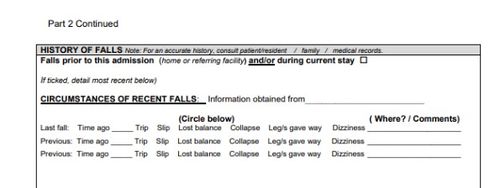What Does Dementia Fall Risk Do?
Table of ContentsDementia Fall Risk Things To Know Before You BuyOur Dementia Fall Risk DiariesThings about Dementia Fall RiskExamine This Report on Dementia Fall Risk
A loss risk evaluation checks to see just how most likely it is that you will certainly drop. The analysis usually consists of: This consists of a collection of questions concerning your overall health and wellness and if you have actually had previous drops or problems with equilibrium, standing, and/or strolling.STEADI consists of testing, evaluating, and intervention. Interventions are referrals that may minimize your danger of dropping. STEADI consists of 3 steps: you for your danger of succumbing to your danger factors that can be enhanced to attempt to protect against falls (as an example, balance problems, damaged vision) to reduce your danger of falling by using reliable strategies (as an example, providing education and resources), you may be asked several concerns including: Have you fallen in the past year? Do you really feel unstable when standing or strolling? Are you fretted about dropping?, your supplier will certainly examine your stamina, equilibrium, and stride, making use of the following autumn assessment devices: This test checks your gait.
If it takes you 12 seconds or even more, it may suggest you are at greater danger for a loss. This test checks toughness and balance.
The settings will get more difficult as you go. Stand with your feet side-by-side. Relocate one foot midway ahead, so the instep is touching the large toe of your other foot. Move one foot totally in front of the other, so the toes are touching the heel of your various other foot.
The Ultimate Guide To Dementia Fall Risk
A lot of falls happen as a result of multiple contributing factors; therefore, managing the risk of dropping starts with recognizing the variables that add to fall danger - Dementia Fall Risk. A few of one of the most relevant danger aspects include: History of prior fallsChronic clinical conditionsAcute illnessImpaired stride and balance, lower extremity weaknessCognitive impairmentChanges in visionCertain risky medicines and polypharmacyEnvironmental elements can also increase the threat for drops, consisting of: Insufficient lightingUneven or harmed flooringWet or slippery floorsMissing or harmed handrails and get barsDamaged or incorrectly fitted tools, such as beds, wheelchairs, or walkersImproper use of assistive devicesInadequate guidance of individuals living in the NF, including those who show aggressive behaviorsA effective autumn danger administration program calls for an extensive professional analysis, with input from all members of the interdisciplinary group

The care strategy must also consist of treatments that are system-based, such as those that promote a secure environment (proper lighting, handrails, get bars, etc). The effectiveness of the treatments should be evaluated occasionally, and the treatment plan revised as my explanation essential to reflect modifications in the autumn threat evaluation. Executing a fall threat management system using evidence-based finest technique can lower the occurrence of falls in the NF, while limiting the capacity for fall-related injuries.
Dementia Fall Risk Fundamentals Explained
The AGS/BGS standard advises screening all grownups aged 65 years and older for autumn danger every year. This screening includes asking individuals whether they have actually fallen 2 or more times in the past year or sought medical interest for an autumn, or, if they have not fallen, whether they really feel unstable when strolling.
Individuals who have actually fallen once without injury needs to have their equilibrium and stride reviewed; those with stride or balance irregularities need to obtain added assessment. A history of 1 loss without injury and without learn this here now stride or balance problems does not call for additional evaluation past ongoing annual loss threat testing. Dementia Fall Risk. An autumn danger assessment is required as component of the Welcome to Medicare examination
.png)
3 Easy Facts About Dementia Fall Risk Explained
Documenting a drops background is one of the top quality signs for autumn prevention and management. A critical component of risk analysis is a medication evaluation. A number of classes of drugs enhance loss danger (Table 2). copyright medicines specifically are independent forecasters of falls. These medicines often tend to be sedating, alter the sensorium, and impair equilibrium and stride.
Postural hypotension can frequently be relieved by decreasing the dose of blood pressurelowering medicines and/or stopping medications that have orthostatic hypotension as a side effect. Use of above-the-knee support hose pipe and resting with the head of the try these out bed boosted might likewise decrease postural decreases in high blood pressure. The preferred aspects of a fall-focused physical examination are displayed in Box 1.

A TUG time greater than or equivalent to 12 seconds suggests high loss danger. Being not able to stand up from a chair of knee elevation without making use of one's arms suggests increased loss danger.